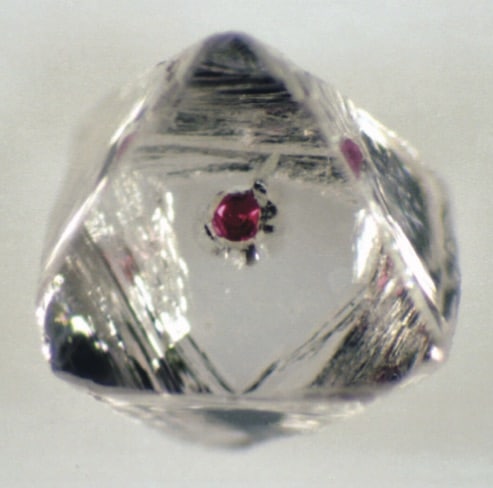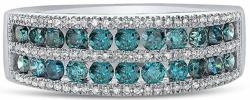Diamonds Inclusions
Diamonds Inclusions are acquired naturally by diamonds during their formative years deep within the womb of mother earth and are akin to birthmarks. These flaws are created due to irregular crystallization of diamond during its formation process.
A diamond responds to incident light in three different ways. It allows a portion of light to pass through itself; it reflects another portion and refracts yet another portion of the incident light within itself. This dispersion and refraction of light is what makes the diamond sparkle.
When the path or wavelength of incident light is obstructed or diverted, the play of light does not occur. Depending on the size and type of the obstruction, this can impart a dull and lifeless look to the diamond.
Such obstructions are caused by flaws of the diamond that may either be internal or external or both. External flaws occurring on the surface of the diamonds are called blemishes while internal faults occurring within the crystalline surface of the diamond are known as inclusions.
Blemishes can be man-inflicted during mining, cutting & polishing or they may also have been acquired naturally.
One must understand clearly that diamonds are formed deep within the earth in the crudest of environments under unimaginable conditions of temperatures and pressures. These conditions are far removed from those of a sterile laboratory.
As a result, it is normal for diamonds to have inclusions. Inclusions are present in diamonds as a rule rather than as exceptions.
Nevertheless, inclusions need not be looked upon with distaste, if they are small and have a negligible effect on the brilliance and clarity of a diamond. In fact, the inclusions present in individual diamonds are as unique as the human fingerprint and are recorded in detail in the diamond’s gradation report.
Garnet Inclusion in Diamond
Stephen Richardson, University of Cape Town, South Africa, CC BY-SA 2.5, via Wikimedia Commons.
Most inclusions do not affect the beauty of a diamond and are considered to be identifying characteristics. They allow you to properly identify your own diamond in case it happens to get lost or stolen or mixed up with other diamonds when given for cleaning or appraisal.
However, if the inclusions are too dense or widespread, they can affect the properties of the diamond in many ways:
- Diamond Brilliance: An inclusion affects the diamond’s ability to scatter and transmit light as it obstructs the light passing through diamond. Consequently, it reduces the brilliance of diamond.
- Durability: Inclusions can reduce the diamond’s resistance to fracture significantly.
- Beauty: Sizeable inclusions or colored inclusions mar the beauty of the diamond.
- Price: Value of the diamond decreases with increase in size and number of inclusions.
Some examples Internal Flaws or Inclusions found in diamonds are as under:
Feathers:
‘Feather’ is a general term for fissures that might exist in a diamond. They are hairline cracks within the stone that resemble (as the name suggests) feathers. Small feathers do not usually threaten the diamond’s structure unless they rise to the surface on the top of the stone, where they are particularly prone to accidental blows.
Depending on the direction from which they are viewed, a feather may look shiny and white, glossy, or transparent. Some feathers capture the incident light and blink from transparent to bright when the stone is moved to and fro.
Compared to any other inclusion, feathers present a greater durability threat to the diamond because a hard knock can enlarge them at any time. Ultrasonic cleaning can further pry open and expand the feathers.
Included crystals or minerals:
Diamonds can get permeated with tiny crystals and minerals because of the extreme conditions they have to undergo during the course of their formative years. Very often these crystals are smaller diamond particles inside a larger diamond. These foreign particles obstruct the play of incident light and thus detract from the clarity, grade and value of the diamond.
But, there are times when the naturally implanted crystal can have a positive impact and add character to a diamond. For example, a diamond with a small garnet embedded in it would be a great personal choice for someone whose birthstone is a garnet.
Knots:
Sometimes, an included diamond crystal sitting near the surface of the diamond reaches and opens to the surface during cutting and polishing and it is called a knot. It can give the diamond cutter lot of trouble while fashioning the diamond.
The knot is visible like a raised area on a facet. The boundary between the host diamond and the knot can be viewed under high magnification and proper lighting. You may also see the tell-tale trailing lines alongside the knot where tiny rubble of diamond had been inadvertently dragged across the surface by the polishing wheel.
Since the knot is an entirely different diamond crystal in itself, its growth pattern differs from that of the host diamond. Most of the times it is not feasible for the diamond cutter to polish the knot away. Knots can greatly reduce the clarity and thus the value of a diamond.
Cavities:
Cavities are just what their name suggests. They are holes on the surface of the diamond. Cavities can be caused because of two reasons.
When a surface reaching crystal is forced out during polishing or if it simply drops out, it leaves behind a gaping hole called the cavity. Also, when a part of a feathering close to the diamond surface breaks off leaving behind a deep cleft-like opening, it is called a cavity. The tell-tale drag lines alongside the cavity where tiny rubble of diamond had been inadvertently dragged across the surface by the polishing wheel differentiate a cavity from a chip.
Cavities can crop up anywhere on a diamond, including the crown, pavilion or girdle. It can affect clarity just like an inclusion inside the diamond. But, a cavity has a more negative impact on the value of the stone since the cavity can turn dark with accumulated grime of everyday wear.
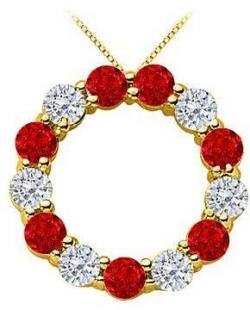
|
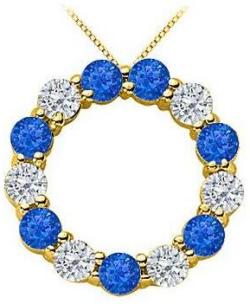
|
|
| 14K Yellow Gold Natural Ruby and Diamond Circle of Life Eternity Pendant in 2 Carat TGW | Circle of Life Eternity Pendant of 2 Carat Diamond and Natural Blue Sapphire in Yellow Gold 14K |
Click On The Images
Twinning Wisps or Intergrowth:
The term Twinning Wisps or Intergrowth does not refer to a single inclusion but rather to a group of inclusions that have intertwined together in a twinning plane. This motley group consists of a mixture of inclusions such as pinpoint size diamond crystals, feathers, fractures, crystals, and clouds.
These are formed during the formative years of the stone when the diamond crystal is forming and growing. Typically, they are ribbon like bands stemming at the center of the diamond and look like white striping within the diamond similar to stretch marks on the belly skin of a pregnant woman.
Twinning wisps are more prevalent in fancy shape diamonds like heart shapes, pear shapes and triangles which are usually created from twinned crystals. Then again, twinning wisps can also be found in other diamond shapes too, based upon the quality of the rough diamond used to fashion out the stone.
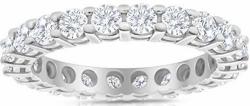
|

|
|
| 2.00ctw Diamond Eternity Band in 14k White Gold | Jewelry Art 1.00 CT TW Prong Set Round Diamond Anniversary Wedding Ring in 14k White Gold |
Click On The Images
Cleavage:
Cleavage is a straight crack in a diamond (with no feathering) in its cleavage plane. The cleavage plane is a weak crystal direction along one or more of the diamond’s four octahedral planes.
A cleavage can make the diamond more brittle as it has the potential to crack the stone into two pieces. However the minute unnoticeable cracks do not affect the diamond’s build directly and tiny cracks that are invisible in a table-up (face up) position do not seriously affect clarity ratings of the diamond.
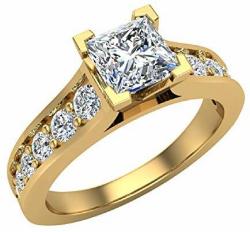
|
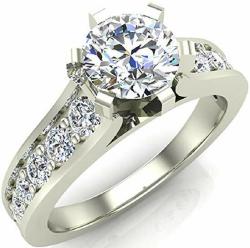
|
|
| 1.07 ct tw Diamond Accented Solitaire Engagement Ring 14K Gold (G,SI) | 1.00 ctw Riviera Shank Diamond Engagement Ring 18K Gold (G,SI) |
Click On The Images
Bearding or Bearded Girdle or Girdle Fringes:
As evident from the name, Bearded Girdle or Girdle Fringes are beard-like hair streaks that appear around the girdle of the diamond.
This type of inclusion consists of minute feathers stretching from the girdle surface into the stone and is a result of hastiness in the bruting process when giving the diamond its initial shape in the cutting process.
A thinly bearded girdle has very few and very fine feathers sprinkled around the diamond’s border and might not de-valuate the diamond quality.
A thickly bearded girdle has a multitude of feathers that together create a fuzzy gray fringe all the way around the stone. It should be removed or refined away by cutting the diamond again.
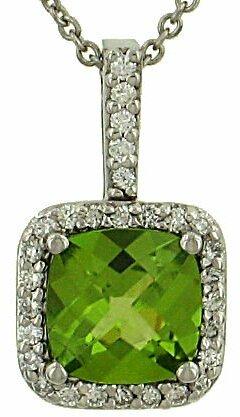
|
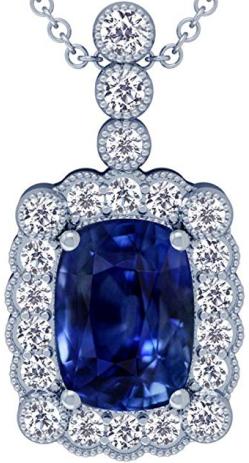
|
|
| Pave Diamond and Peridot Pendant | Platinum Cushion Cut Blue Sapphire And Round Diamond Pendant (GIA Certificate) |
Click On The Images
Chip:
A chip is a shallow opening located on the surface of the diamond caused due to the chipping off or gouging out of a small piece of the diamond. The opening typically has a rounded outline and occurs on the edges of the girdle, culet or facet. (It should not be confused with the term “Diamond Chip” which refers to very small diamonds).
Since the chip is the result of damage that occurs subsequent to cutting and polishing, it will not be flanked by trailing drag lines.
Usually, most chips are too tiny to be of any significance and can be eliminated from the diamond surface, by re-cutting or polishing the gem with negligible loss in carat weight. On the other hand, bigger chips may perhaps require re-cutting of the entire diamond causing substantial loss of diamond weight.
Dark Spot:
This is a thin, flat inclusion or a small crystal inclusion that reflects light like a mirror. The inclusion could also appear like a metallic silvery reflector.
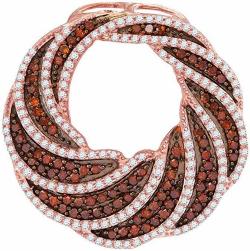
|
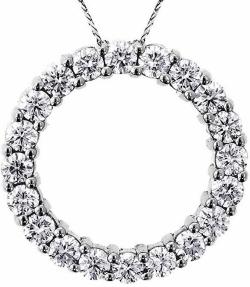
|
|
| 10k Rose Gold Red Diamond Striped Circle Pendant | 3.00 CT TW Round Diamond Eternity Pendant in Platinum |
Click On The Images
Pinpoints:
Are tiny crystals that appear like whitish dots (occasionally they can also be dark in color) inside a diamond and are difficult to see. They look like tiny dots at 10X magnification.
At times, the minute pinpoints can bunch together in clusters giving a hazy look to that area called a cloud. A cloud can negatively impact a diamond’s clarity.
Clouds:
As stated above, clusters of minute pinpoints causing blurry cloud like areas in the diamond are called ‘Clouds’. They create an ugly spot in the diamond and depreciate its clarity rating and value.
Individually, the pinpoints may perhaps be too small to be distinguished at 10X magnification, but crowded together they seem like wispy white or gray patches. Some clouds look like a light haze, while others are dense and almost opaque.
Laser Lines
Unlike most other diamond inclusions laser lines are man-made rather than natural. When a laser beam is used to eliminate dark inclusions present in a diamond, the beams leave behind vapor like trails called the laser lines.
The marks look like filaments stretching inward from the diamond’s table and stopping at the point where the inclusion was removed.
14K White Gold 0.10 Carat Diamond and 0.65 Carat Blue Diamond Ring
Click On The Image
Laser Drill Hole:
The laser drill-hole is a tiny tunnel produced by a laser beam. The tunnel extends from the surface to a dark included crystal (or to the spot from where such a crystal has been removed). After drilling, Sulfuric acid is introduced into the drill hole by immersing the diamond in the acid to dissolve or bleach the inclusion and make it less visible.
The fine bore holes are easily detectable under microscopic examination. They are whitish and straight, but may also change direction slightly. They are often described as having a ‘wrinkled’ appearance. In reflected light, the surface reaching holes can be spotted as dark circles opening through the diamond’s facets.
The Gemological Institute of America grades laser drilled diamonds since the holes are permanent features and the drilling aspect is noted under the comments section.
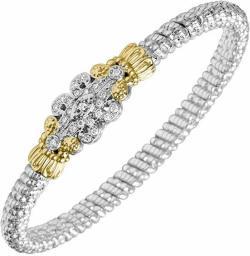
|
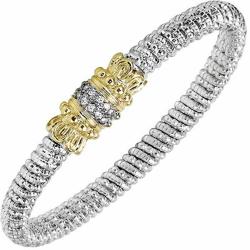
|
|
| Sterling Silver & 14K Gold with 0.25cttw Round-Cut Diamonds Bracelet | Sterling Silver & 14K Gold with 0.18cttw Round-Cut Diamonds |
Click On The Images
Growth or Grain Lines:
It is common knowledge that the metamorphosis of carbon into diamonds occurs in conditions that are far from ideal or sterile. Grain lines are created by irregular crystallization that takes place when a diamond is forming.
These can only be observed while slowly rotating the diamond under examination. They appear and disappear instantaneously and usually appear as groups.
Colorless grain lines do not usually affect diamond clarity unless they are present in large masses and can be seen from the crown side of the diamond.
Internal graining is also caused by uneven crystal growth and can appear like lines, angles, or curves. It can be colored, whitish, or reflective. Internal graining can give part or all of the stone a hazy texture.
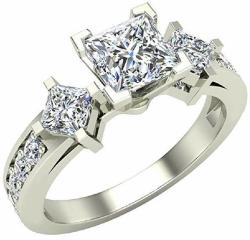
|
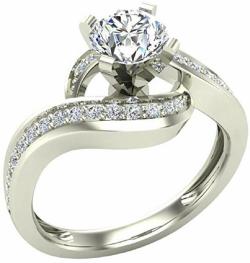
|
|
| 1.15 ct tw Princess Cut Diamond Engagement Ring 14K Gold (J,I1) | Intertwined Diamond Engagement Ring Solitaire Loop 14k Gold 1.00 ct – GIA Certificate |
Click On The Images
Fracture Filled
Surface reaching feathers and Laser drill holes are sometimes filled with substances like molten glass in a treatment called fracture filling. The filler makes the flaw less evident.
It can be difficult to detect, but the treatment leaves a telltale sign called the flash effect. It refers to the bright flashes of color seen when a fracture-filled diamond is rotated. The colors of these flashes range from electric blue or purple to orange or yellow, depending on lighting conditions. The flashes are best seen with the field of vision just about parallel to the plane of the filled fracture.
The Gemological Institute of America does not grade fracture filled diamonds because the treatment is not permanent.
Bruise
A bruise is a tiny area of impact (minor chip or concussion on the stone) surrounded by small root-like feathers visible at 10X magnification. When viewed through an opposing facet, a bruise appears cottony in texture as it radiates into the diamond.
A bruise is sometimes called a percussion mark and is caused by a hard blow.
The presence of a tiny bruise can make the difference between an IF and a VVS1 grade.
Read More Articles About Diamonds
See Also:
Fascinating Facts About Diamonds Straight From Tiffany & Co’s Chief Gemologist
